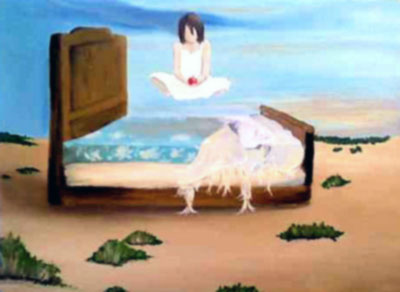All Nonfiction
- Bullying
- Books
- Academic
- Author Interviews
- Celebrity interviews
- College Articles
- College Essays
- Educator of the Year
- Heroes
- Interviews
- Memoir
- Personal Experience
- Sports
- Travel & Culture
All Opinions
- Bullying
- Current Events / Politics
- Discrimination
- Drugs / Alcohol / Smoking
- Entertainment / Celebrities
- Environment
- Love / Relationships
- Movies / Music / TV
- Pop Culture / Trends
- School / College
- Social Issues / Civics
- Spirituality / Religion
- Sports / Hobbies
All Hot Topics
- Bullying
- Community Service
- Environment
- Health
- Letters to the Editor
- Pride & Prejudice
- What Matters
- Back
Summer Guide
- Program Links
- Program Reviews
- Back
College Guide
- College Links
- College Reviews
- College Essays
- College Articles
- Back
Dreamcatchers: History and Legends
Do you ever wish there was a way to destroy those horrifying dreams you have, do it with dreamcatchers! I am going to talk about the origin, parts, and how the dream catcher is made. Try and make your own dreamcatcher!
Dream catchers have been known to chase bad dreams away since the 1960s during the Pan-Indian Movement. After that dream catchers were supported by other Native American tribes. The first tribe to endorse dream catchers was the Ojibwe tribe. They tell stories of a spider-like woman named Asibikaashi. She is known to look after the children and people of the nation. A problem came with Asibikaashi looking after the people because they moved to North America. To protect the people when Asibikaashi couldn’t, the elders and mothers would weave a “magical web for the children with willow hoops or cordage made from plants” (http://en.wikipedia.org/wiki/Ojibwe). The Ojibwa culture believe that the hoop would represent the sun. When the web of the hoop connects in seven places around it, it represents the Seven Prophecies (seven epochs of Turtle Island or North America where they lived.) The feathers mean life. They say that dreamcatchers filter your dreams and bad dreams get caught in the web to be later burned off by the sun. Good dreams go through the hole in the center, past the feathers and into your head. Other tribes that dream catchers became popular in was the Lakota, Cherokee, and Navajo, they believed that good dreams get caught in the web and when they do, they are with the owner of the dreams as long as they live. In every dreamcatcher there is a hole in the center and bad dreams pass through it and are powerless. In their culture, there is a catch to the dreamcatcher, it only worked if you believed in the Great Spirit. They believes that the dream catcher holds the future.
The parts used in the dreamcatcher are the hoop, ring, the beads(different color means different things), the web (string), and the feathers. The string is to be woven around the hoop similarly to a spider web to represent Asibikaashi. While weaving, you can put the beads on the string in different places. The feathers are attached to the bottom of the dreamcatcher. The beads are different colors. Blue means Father Sky and who lives there; grandfather sun, grandmother moon, star nation, and creation. Purple means the inner self, the creator inside them. Yellow is the direction of the East where the Yellow Nation is, it’s where they call their ancestors for wisdom. Red is for Red nation where you call your ancestors to teach you to care for the land. Black represents two roads, Black Nation lets them call upon your ancestors to help you. The black road is destruction and abuse. White Nation recognizes the Caucasian people and their families. Green is Mother Earth who feeds, clothes and protects you. The ring has two meanings, the Earth Mother and when the ring is covered with multi-color wool it means mind and spirit. The web is the connection to the spider brother of life to repair “the eternel web of life”. The feathers are taken from the Eagle, the most sacred animal to Native Americans.
What you need to make a dreamcatcher is a hoop (wooden or metal), some thick string that is long enough to hand some feathers on your hoop, and different color beads. Also, some feathers and thread. First off, make a loop on the middle-top area of your hoop with the thread for hanging your dreamcatcher when done. Don’t cut off the excess string at the bottom! To start the web, make stitches. Hold the excess string of the loop you just made and with it, loosely wrap it around the top of the hoop. Move the string to the back (making a hole) and put it through the loop you just made. That is your stitch, continue spacing them 1-2 inches apart around the hoop. The last stitch should be placed about a half inch away from the loop you first made. You can add beads in-between each stitch. Continue the same thing until you get to the middle of the hoop. After doing this, add on feathers where you choose and make sure the knot is secured. For a more detailed directions, you can go to http://www.nativetech.org/dreamcat/dreminst.html. Your dreamcatcher should basically look like a hoop with string that looks like a whole bunch of flower-like petals on top of each other going in a circle. Also, it should have feathers if you choose and beads of many colors. You should have a loop on the top to be able to hang the dreamcatcher.
To conclude, this information taught you the origin, parts, and how the dreamcatcher is made. You can check out my sources for more information on dreamcatchers. Hopefully, you can make your own dreamcatcher and it may protect your mind from bad dreams.

Similar Articles
JOIN THE DISCUSSION
This article has 0 comments.
